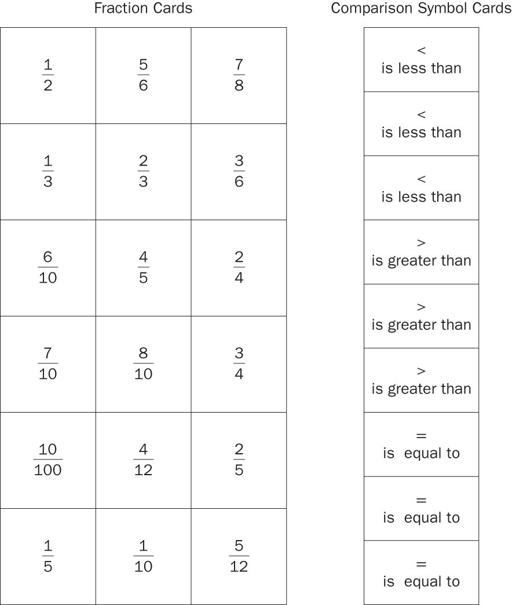Teaching the Common Core Math Standards With Hands-On Activities, Grades 3-5 (31 page)
Read Teaching the Common Core Math Standards With Hands-On Activities, Grades 3-5 Online
Authors: Judith A. Muschla,Gary Robert Muschla,Erin Muschla-Berry
Tags: #Education, #Teaching Methods & Materials, #Mathematics, #General

BOOK: Teaching the Common Core Math Standards With Hands-On Activities, Grades 3-5
5.22Mb size Format: txt, pdf, ePub
Activity: Comparing Fractions
Working in pairs or groups of three, students will select values from fraction cards, and, using comparison symbols, will write inequalities or equations.
Materials
Scissors; reproducible, “Fraction Cards and Comparison Symbols,” for each pair or group of students.
Procedure
1.
Review the methods for comparing fractions, as noted in the Background, with your students. If necessary, also review the meaning of the inequality and equal symbols.
2.
Distribute copies of the reproducible. Explain that it contains 18 Fraction Cards and 9 Comparison Symbol Cards. Note that the symbols are also labeled so that the inequality symbols are not inadvertently turned upside down.
3.
Explain that students are to cut out the cards and use them to form six inequalities and three equations. Note that there may be several ways to do this. They must use every fraction card and each comparison symbol card, but only once.
4.
Instruct your students to arrange the cards to form all six inequalities and three equations first, and then write the comparisons on a separate sheet of paper.
Closure
Review the comparisons with your students. Note some of the many different comparisons that are possible. Ask for volunteers to explain what strategies they used to write their comparisons.
Answers
Comparisons may vary; following are some examples.
(1)(2)
(3)
(4)
(5)
(6)
(7)
(8)
(9)
Fraction Cards and Comparison Symbols
Number and Operations—Fractions: 4.NF.3
“Build fractions from unit fractions by applying and extending previous understandings of operations on whole numbers.”
3. “Understand a fractionwith
as a sum of fractions
.
Other books
Blanco County 03 - Flat Crazy by Rehder, Ben
Against Medical Advice by James Patterson
Cluster Command: Crisis of Empire II by David Drake, W. C. Dietz
Crossing by Andrew Xia Fukuda
The Trouble With Bodyguards: Part 1 by Kristina Blake
Away from Home by Rona Jaffe
Patriot Acts by Greg Rucka
Emerald [Pyrate's Treasure 2] (Siren Publishing Classic) by Cooper McKenzie
The Secrets of Peaches by Jodi Lynn Anderson
Shuteye for the Timebroker by Paul Di Filippo


